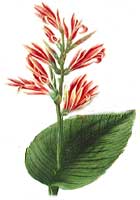| Are You? |
What is a CANNA anyway?
CANNA spp. Canna (E); Achira (C); Achiva (S); Bandera de uriba (C); Cafe cimarron (P); Capacho (C); Chisgua (C); Chumbima (C); Maraca (Ch) . The roots of some species serve as a source of starch allowed to diabetics (!). The seeds are used in necklaces, rattles, and popguns. the leaves are used for wrapping food. Leaves and tubers serve as fodder. In certain parts of Colombia, cakes are made from the flour extracted from the roots. the plant is considered diuiretic and emollient. Necklaces of the seeds, sometimes accompanied with the teeth of the fish payara, are supposed to drive off the "mal de ojo" and to make the teeth grow strong. The leaves and rhizomes are considered refrigerant and rubefacient, and are recommended for epilepsy. The leaves are used as cataplasm for hernias.
FROM: http://www.biologie.uni-hamburg.de/b-online/ibc99/dr-duke/c.html
CANNA spp. Canna (E); Achira (C); Achiva (S); Bandera de uriba (C); Cafe cimarron (P); Capacho (C); Chisgua (C); Chumbima (C); Maraca (Ch) . The roots of some species serve as a source of starch allowed to diabetics (!). The seeds are used in necklaces, rattles, and popguns. the leaves are used for wrapping food. Leaves and tubers serve as fodder. In certain parts of Colombia, cakes are made from the flour extracted from the roots. the plant is considered diuiretic and emollient. Necklaces of the seeds, sometimes accompanied with the teeth of the fish payara, are supposed to drive off the "mal de ojo" and to make the teeth grow strong. The leaves and rhizomes are considered refrigerant and rubefacient, and are recommended for epilepsy. The leaves are used as cataplasm for hernias.
FROM: http://www.biologie.uni-hamburg.de/b-online/ibc99/dr-duke/c.html


2 comments:
I'm the same flower as you!
I like the Canna and the description.
Post a Comment